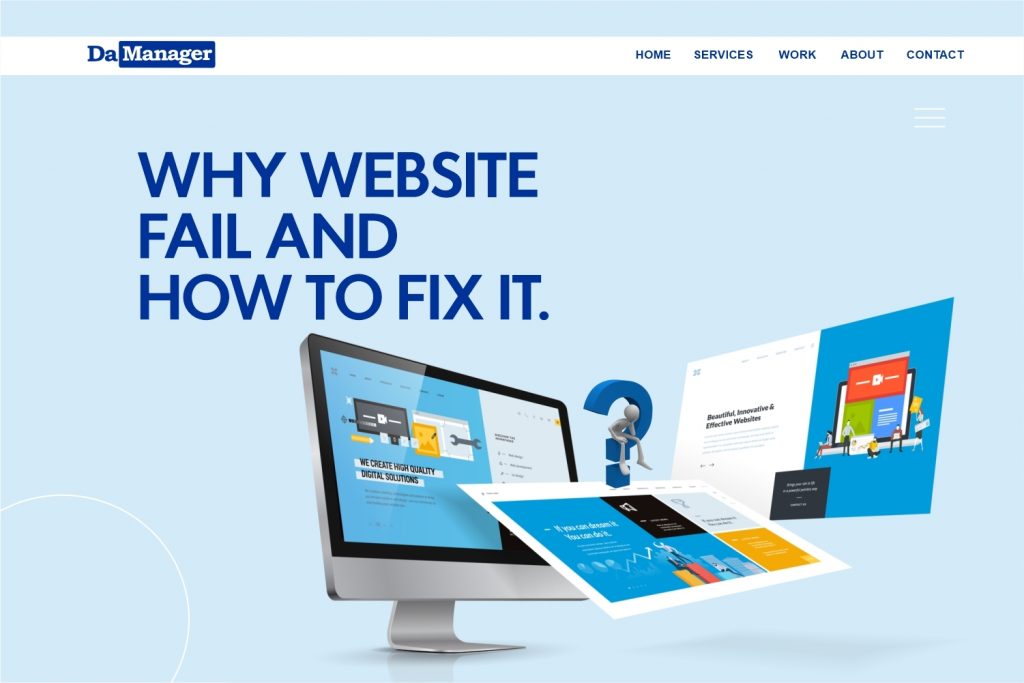Table of Contents
In today’s digital landscape, website failures are a common challenge, despite a well-crafted website being the cornerstone of your online presence. It’s your digital storefront, business card, and, in many cases, your primary means of reaching your target audience. However, not all websites succeed. There are several common reasons why a website might fail, and in this blog post, we’ll explore these pitfalls and provide actionable solutions to ensure your website survives and thrives.
Poor User Experience (UX)The Problem
Websites that frustrate users with slow loading times, confusing navigation, or a lack of mobile responsiveness can quickly drive visitors away.
The Solution
- Optimize your website for a seamless user experience. Ensure fast loading times through image optimization and efficient coding.
- Implement responsive design techniques to ensure your site is mobile-friendly.
- Regularly test your website on different devices and browsers to identify and rectify any issues.
Outdated Content
Stale, outdated content can make your website seem abandoned and irrelevant, diminishing its value.
The Solution
- Create a content calendar to consistently update your website with fresh and valuable content.
- Incorporate blog posts, news articles, or product updates to keep your audience engaged.
- Delete or redirect obsolete pages to maintain a tidy and up-to-date website.

Inadequate SEO
If your website isn’t properly optimized for search engines, it won’t rank well in search results, making it harder for potential visitors to find you.
The Solution
- Conduct thorough keyword research to understand what your target audience is searching for.
- Optimize meta tags, meta descriptions, and headings with relevant keywords.
- Create high-quality, keyword-rich content and interlink-related pages on your website.
- Regularly monitor your website’s SEO performance with tools like Google Search Console and Google Analytics and make improvements accordingly.
Lack of Mobile Optimization
With the majority of internet users accessing websites on mobile devices, a non-mobile-friendly website can lead to failure.
The Solution
- Implement responsive design techniques to ensure your website looks and functions well on all screen sizes.
- Google’s mobile-friendliness test can help identify areas for improvement.
Slow Loading Times
Users expect websites to load quickly, and slow loading times can lead to high bounce rates and lost opportunities.
The Solution
- Compress images and other assets to reduce file sizes.
- Leverage browser caching to store frequently accessed elements locally on users’ devices.
- Minimize HTTP requests by using efficient coding practices.
- Utilize content delivery networks (CDNs) for faster loading times.
- Use tools like Google PageSpeed Insights to identify and address loading time issues.
Inadequate Security
Website security breaches can lead to data loss, damage your reputation, and scare away users.
The Solution
- Implement security protocols, including a secure sockets layer (SSL) to enable HTTPS.
- Keep your website software, themes, and plugins up-to-date to patch vulnerabilities.
- Use strong, unique passwords and enable two-factor authentication for added security.
- Regularly monitor for security vulnerabilities and apply patches as needed.
Poor Content Quality
Low-quality, uninformative, or poorly written content can discourage visitors from staying on your site.
The Solution
- Invest in creating high-quality content that provides value to your audience.
- Proofread and edit your content to eliminate grammatical errors and ensure clarity.
- Fact-check and cite your sources to build credibility.
- Ensure your content is well-structured and engaging, using visuals, lists, and subheadings to break up text.
Neglected Maintenance
Over time, websites can become cluttered with broken links, outdated plugins, and other issues if not regularly maintained.
The Solution
- Create a website maintenance schedule to ensure that your site is running smoothly.
- Regularly check for broken links and fix or redirect them.
- Update plugins and themes to their latest versions to benefit from security patches and new features.
- Perform routine backups to safeguard your website’s data.
Additional Tips for Success
In addition to addressing the common reasons for website failure, consider these additional tips for a thriving online presence:
- Clear Call-to-Action (CTA): Ensure that your website has clear and compelling CTAs to guide users toward your desired actions, whether it’s subscribing, buying, or contacting you.
- Engaging Visuals: Use high-quality images, videos, and graphics to make your website visually appealing. Visual content can capture users’ attention and convey information more effectively.
- Analytics: Utilize web analytics tools like Google Analytics to track your website’s performance, user behaviour, and demographics. This data can help you make informed decisions to improve your site.
- Social Media Integration: Promote your website through social media channels to expand your reach and engage with your audience. Social sharing buttons can encourage visitors to share your content, increasing your online visibility.
Conclusion
By addressing these common issues and implementing the suggested solutions, you can significantly improve your website’s chances of success and ensure it remains a valuable asset for your online endeavours. Keep in mind that websites require ongoing attention, so regular monitoring and updates are crucial for long-term success. Your website is not just a digital presence; it’s a dynamic platform that requires care and dedication to flourish.
This article was originally published in 26 October 2021. It was most recently updated in December 7, 2023 by Isah Progress























